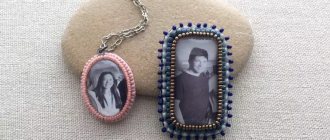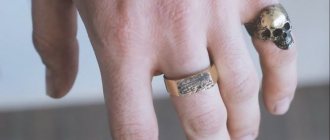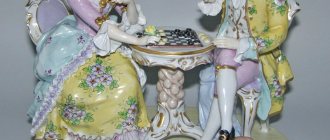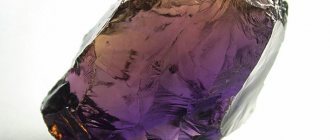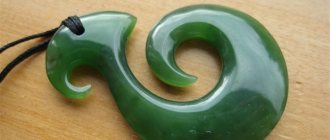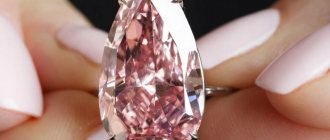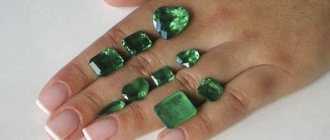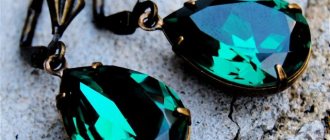A medallion is a round or oval pendant on a chain, inside of which you can put any miniature thing, for example a photograph of a loved one or a lock of hair. The decoration consists of two parts connected by a hinge and opens like a book.
This accessory is shrouded in mystery and always becomes something special for its owner, as it contains his personal secret.
Its main difference from a pendant is that the medallion looks like a small flat box, inside which you can hide something. The pendant can be of any shape.
It is known that the famous Carl Faberge began his career with gold opening medallions.
What types of neck pendants are there?
Pendants are jewelry and costume jewelry that can be hung anywhere: on a chain or cord, on a watch or bracelet, brooch or even handbag.
Neck pendants are usually called pendants or medallions. It is impossible to make a clear distinction between them, but the concept of a medallion is narrower. Most types of medallions are made from jewelry and costume jewelry alloys and have a rounded, flattened shape, while pendants are more diverse in materials and designs.
The word “pendant” is more associated with feminine jewelry, while “medallion” is more associated with masculine jewelry. But this is not a dogma: medallions can be worn by beautiful ladies of any age and status.
The types of pendants amaze the wildest imagination. They may vary in:
- Materials. Jewelry pendants are made primarily from gold and silver (less commonly platinum). The pendant can be a single stone fastened with a precious metal, a carved decoration made of ivory or an ornamental mineral - there are a lot of options. The materials for jewelry pendants are simpler metal alloys (steel, copper, titanium), all kinds of organics (leather, wood, bone, coral), ceramics, glass in all its many forms, and even plastic.
- Availability of inserts and decor. Both natural minerals and organics, as well as beads, rhinestones, plastic, synthetic stones and much more are used as inserts. In addition to or instead, engraving, diamond cutting, filigree, embossing, glazing, painting, and so on can be used as decoration. And sometimes a pendant plays only due to its shape and material, without the need for additional decorations.
- Style direction. Using a pendant or medallion, you can complement absolutely any look: sporty, classic, formal, casual, romantic, evening, and so on. Pendants in the boho style are especially popular now: luxurious, large, richly and variedly decorated. But it cannot be said that more elegant and laconic options have been forgotten. Strict geometry and provocative asymmetry are held in high esteem.
In recent years, there has been a pronounced trend towards multi-layering. Now the rope for the pendant can be adjacent to a similar or made from a different material, chain, beads or necklace - the main thing is that the jewelry matches the design.
If you don't like chains, they can be replaced with a cord around your neck for hanging. It's called gaitan and is an excellent alternative to the classic version. If you wish, you can wear the medallion on a velvet, leather or rubber choker - there are countless options!
Now let's take a closer look at the different types of pendants.
History of decoration
The very concept of “medallion” originated in Ancient Rome . At that time, this was the name for a rounded disk, more like a large gold coin , which was hung around the neck of a military leader during a triumph.
In the Middle Ages, such decoration was popular among nobles, who most often hid small poisoned needles .
By the end of the Middle Ages, pendants began to be considered insignia. They were especially loved by sailors who hid the hair of their wives and children or pieces of their clothing inside. Such a little secret warmed their souls during long voyages.
During the Renaissance, medallions came back into fashion due to increased interest in antiquity. Accessories have again appeared among the jewelry of every self-respecting fashionista.
Such original pendants also had a practical use : a small pillow . This was an effective way to hide other unpleasant odors.
In the old days, people knew several ways to wear a medallion. Such jewelry was for both men and women, and could be on a belt, attached to clothing, a ring, or simply in a pocket.
Such pendants became most widespread in the 18th-19th centuries during the Victorian era. Many women of that time had a medallion with a photo in memory of their relatives and friends who died in the war.
What is the name of the opening pendant?
A locket is a pendant that opens and closes with a lock, concealing some content that is valuable to the owner. The cover of such a pendant is usually impressively decorated with inserts, chasing, miniatures, glaze, filigree and so on.
In the Middle Ages, religious shrines were often kept in lokets. However, ladies and gentlemen of the world often used these miniature hiding places differently, trusting them with their heartfelt secrets. Their lockets contained curls, notes and portraits of lovers. And sometimes, to be honest, there are bottles of poison.
A pendant in which you can put something is still popular today. Lokets are worn by many: from socialites to ordinary housewives. And the contents are photos of loved ones and children, curls, baby teeth of offspring, talismans hidden from prying eyes, and so on. The main thing is a little secret!
Gold pendant (go to the SUNLIGHT catalogue)
But there is also a trendy modern version of the locket: a pendant with a transparent lid, the contents of which are clearly visible from the outside. And inside they put miniature metal figures (usually silver or multi-colored, covered with glaze), which are called petits.
In meaning and form, petits are most closely related to the deafeningly popular charms: these are the same small hearts, crowns, zodiac signs, clover leaves, horseshoes, and so on. They can be worn several pieces in one locker, changing as needed.
Medieval traditions
Necklaces with silver medallions gained popularity back in the Middle Ages, they were often used as amulets. It was believed that they could ward off evil spirits. But in most cases, small pendants had a more practical meaning. Dry medicinal herbs and flowers were inserted into them. This allowed us to protect ourselves a little from infection and germs, which were everywhere at that time. In addition, the aroma muffled the stench of garbage and sewers running right through the city. For these purposes, a piece of scented fabric was placed inside. Other medallions from this time contained a tiny painted portrait. Of course, from time to time these medallions even contained poison.
Gemma and its types
The art of carving precious and semi-precious stones has been known since antiquity. The result of the work of a master carver is called a gemma.
The most common type of gem is the cameo, with a relief image. Sometimes there are intaglios, where the image, on the contrary, is deepened.
As a rule, gems exist in the form of medallions (both independently and as decoration on the lids of lockets). And they are usually cut from semi-precious and ornamental stones: sardonyx, agate, hematite, carnelian and others like them.
Gold products for men
The variety of design options for men's gold medallions makes it possible to choose the most suitable model for a particular person. A gold medallion can serve not only as a bright accessory, but also as an effective talisman, thanks to which the state of affairs will improve both in terms of personal issues and in spiritual development.
Men's medallion models are made in round, square, oval and rectangular shapes. In addition to the performance properties, when choosing a model, you should think about the possible addition of a pattern - on the surface of the product using engraving, stones or enamel.
Other pendants with contents
Our contemporaries wear wristwatches or abandon them altogether (the time can always be seen on the gadget screen). But before, representatives of the stronger sex wore watches on a chain in a special pocket, and ladies wore them in the form of pendants. Pendant watches have not lost their relevance to this day, having become even more diverse in materials and design.
Information storage pendants, that is, flash drives in jewelry or costume jewelry, are also becoming increasingly popular. Where else to store secret (and all the necessary) information, if not on your chest?
Another interesting option is an aroma pendant. Such pendants are miniature containers made of ceramic, glass or stone, which the owners fill with aromatic oils. Even official medicine does not deny the benefits of aromatherapy!
Our choice
CHLOÉ Emoji necklace
Gold plated brass medallion with embossed fertility symbol.
Buy
ALIGHIERI Lion silver necklace
Handmade silver medallion inspired by an ancient Venetian lion coin.
Buy
ALIGHIERI La Collisione 24kt gold-plated and sterling silver necklace
A delicate lion motif medallion in sterling silver with a gold plated eye for contrast.
Buy
ANISSA KERMICHE Strength 9-karat gold diamond necklace
The round medallion is encrusted with diamonds, which are arranged in the form of the word "strength" written in Braille.
Buy
ELHANATI Roxy Mezuzah Tag 18kt gold necklace
Gold plated medallion in the form of an elegantly textured tag.
Buy
ALIGHIERI The Wandering Muse 24kt gold-plated bronze necklace
Inspired by Dante's Divine Comedy, this medallion is made of bronze and features an oversized lobster clasp.
Buy
LAURA LOMBARDI + NET SUSTAIN Rosa gold-plated necklace
Vintage style brass medallion.
Buy
What is the name of a pendant on a fishing line around the neck?
Here is a dazzling trend of recent seasons: a pendant on a fishing line for the neck. It is often called an invisibility necklace, because the fishing line is almost invisible on the skin. It seems that a pebble, pearl or miniature figurine made of precious metal is magically held on the skin, giving the girl a flair of mystery and romanticism.
Invisibility necklaces are worn in such a way that the stone is located in the seductive notch between the collarbones. This concentrates attention on the neckline area much more than a more voluminous necklace, so if you have aesthetic problems in this area, it is better to choose another piece of jewelry.
A pendant on a fishing line cannot be large: it is always something miniature and laconic. Invisibility necklaces with pendants in the form of a single precious stone (for example, a diamond) in a modest frame look great. The alternative is a very high-quality imitation.
Links
Manufacturing Process Casting · Enameling · Engraving · Filigree · Cladding · Metal-plastic · Polishing · Soldering Tools Die · File · Hammer · Crossbar · Tongs Materials Precious alloys White gold Sterling (silver alloy) Shakudo Shibuichi Electrum Metals/alloys Copper · Bronze · Brass · Mokume · Pewter · Stainless steel · Titanium · Abyssinian gold · Nordic gold · French gold Precious minerals Aventurine · Agate · Alexandrite · Amethyst · Aquamarine · Diamond · Emerald · Garnet · Carnelian · Quartz · Lapis lazuli · Malachite · Moonstone · Jade · Obsidian · Onyx · Opal · Ruby · Sapphire · Sodalite · Chalcedony · Tanzanite · Tiger's Eye · Topaz · Tourmaline · Peridot · Citrine · Jasper Organic materials Noble Coral · Jet · Haliotis · Pearl · Copal · Mother of Pearl · Amber Terms Carat · Precious metals · Rhinestone · Clasp Related articles: Piercing · Gemology · Metalworking · Costume jewelry · Accessory
What is the military medallion called?
In almost all armies of the world, military personnel must carry special badges with identification information. More often, such badges are worn around the neck, but in the Russian army it is customary to wear a personal badge in a special trouser pocket.
The soldier's medallion stores information about the owner. In the simplified version, this is an identification number, in the expanded version, first and last name, gender, date of birth, blood type, and so on.
Silver pendant (go to the SUNLIGHT catalogue)
The name of such “decorations” is quite sad: “death medallions” or simply “suicide bombers”. This is due to the purpose of army medallions: they serve to identify those seriously wounded and killed in battle. In some armies, it is customary to wear two similar medallions at once: one remains on the body, the other is taken with them by the surviving comrades of the deceased.
Despite such a sad meaning, soldier medallions (more precisely, their stylizations) have become a very popular decoration among representatives of the stronger half of humanity. On the back side, the owners engrave their own names and other data (or simply life mottos), and on the front side there can be an icon, state emblem or other significant symbol.
Notes
- Medallion
- article from the Etymological Dictionary of the Russian Language by M. R. Vasmer - ↑ 1 2 3 Medallion
- article from the Great Soviet Encyclopedia. - [caravaggio.ru/?item=802134ff-4d0c-4399-98af-3f3dbc4dae13&termin=37906b4e-817f-4c6f-a88a-7fd33e4137df Medallion]
- Medallions
- Ancient World. Encyclopedic dictionary in 2 volumes. — M.: Tsentrpoligraf. V. D. Gladky. 1998 - Medallion
- Dictionary of Antiquity. — Translation from German. M.: Progress. Leipzig Bibliographical Institute. 1989. - ↑ 12
[colory.ru/?item=b66cfc18-7924-4c9e-b556-b281f8d58c9a&termin=37906b4e-817f-4c6f-a88a-7fd33e4137df Medallion] - Medallion // Encyclopedic Dictionary of Brockhaus and Efron: in 86 volumes (82 volumes and 4 additional). - St. Petersburg, 1890-1907.
- Medallion
- Fashion Encyclopedia. Andreeva R., 1997 - [dragocennosti.dljavseh.ru/Kulony_medal'ony/Medal'ony.html/ Medallions]

